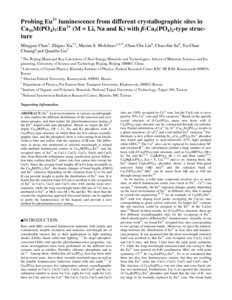Показать сокращенную информацию
Probing Eu2+ luminescence from different crystallographic sites in Ca10M(PO4)7:Eu2+ (M = Li, Na and K) with beta-Ca3(PO4)2-type structure
| Автор | Mingyue, Chen | |
| Автор | Zhiguo, Xia | |
| Автор | Molokeev, Maxim S. | |
| Автор | Chun, Che Lin | |
| Автор | Chaochin, Su | |
| Автор | Yu-Chun, Chuang | |
| Автор | Quanlin, Liu | |
| Дата внесения | 2018-02-07T07:33:32Z | |
| Дата, когда ресурс стал доступен | 2018-02-07T07:33:32Z | |
| Дата публикации | 2017-08 | |
| Библиографическое описание | Mingyue, Chen. Probing Eu2+ luminescence from different crystallographic sites in Ca10M(PO4)7:Eu2+ (M = Li, Na and K) with beta-Ca3(PO4)2-type structure [Текст] / Chen Mingyue, Xia Zhiguo, Maxim S. Molokeev, Che Lin Chun, Su Chaochin, Chuang Yu-Chun, Liu Quanlin // Chemistry of Materials. — 2017. | |
| ISSN | 08974756 | |
| URI (для ссылок/цитирований) | http://pubs.acs.org/doi/abs/10.1021/acs.chemmater.7b02724 | |
| URI (для ссылок/цитирований) | https://elib.sfu-kras.ru/handle/2311/70191 | |
| Описание | Текст статьи не публикуется в открытом доступе в соответствии с политикой журнала. | |
| Аннотация | Eu2+ local environments in various crystallographic sites ena-bles the different distribution of the emission and excitation energies, and then realize the photoluminescence tuning of the Eu2+ doped solid state phosphors. Herein we report the Eu2+-doped Ca10M(PO4)7 (M = Li, Na and K) phosphors with β-Ca3(PO4)2-type structure, in which there are five cations crystallographic sites, and the phosphors show a color tuning from bluish-violet to blue and yellow with the variation of M ions. The difference in decay rate monitored at selected wavelength is related with multiple luminescent centers in Ca10M(PO4)7:Eu2+, and the occupied rates of Eu2+ in Ca(1), Ca(2), Ca(3), Na(4) and Ca(5) sites from Rietveld refine-ments using synchrotron power diffraction data confirm that Eu2+ enters into four cation sites except for Ca(5). Since the average bond lengths d(Ca-O) keep invariable in the Ca10M(PO4)7:Eu2+, the drastic changes of bond lengths d(M-O) and Eu2+ emission depending on the variation from Li to Na and K can provide insight to probe the distribution of Eu2+ ions. It is found that the emission band 410 nm is as-cribed to the occupation of Eu2+ in Ca(1), Ca(2) and Ca(3) sites with similar local environments, while the long-wavelength band (466 nm or 511 nm) is attributed to Eu2+ at M(4) site (M = Na and K). We show that the crystal-site en-gineering approach discussed herein can be applied to probe the luminescence of the dopants and provide a new method for photoluminescence tuning. | |
| Название | Probing Eu2+ luminescence from different crystallographic sites in Ca10M(PO4)7:Eu2+ (M = Li, Na and K) with beta-Ca3(PO4)2-type structure | |
| Тип | Journal Article | |
| Тип | Journal Article Preprint | |
| ГРНТИ | 29.31.23 | |
| Дата обновления | 2018-02-07T07:33:32Z | |
| DOI | 10.1021/acs.chemmater.7b02724 | |
| Институт | Институт инженерной физики и радиоэлектроники | |
| Подразделение | Базовая кафедра физики твердого тела и нанотехнологий | |
| Журнал | Chemistry of Materials | |
| Квартиль журнала в Scopus | Q1 | |
| Квартиль журнала в Web of Science | Q1 |

